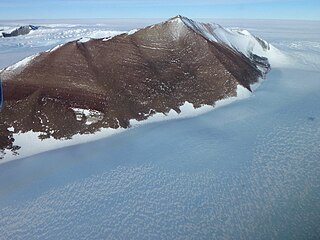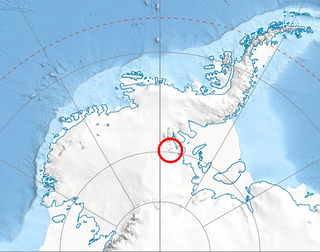Related Research Articles

The Pensacola Mountains are a large group of mountain ranges and peaks that extend 280 nautical miles in a northeast–southwest direction in the Transantarctic Mountains System, Queen Elizabeth Land region of Antarctica. They comprise the Argentina Range, Forrestal Range, Dufek Massif, Cordiner Peaks, Neptune Range, Patuxent Range, Rambo Nunataks and Pecora Escarpment. These mountain units lie astride the extensive Foundation Ice Stream and Support Force Glacier which drain northward to the Ronne Ice Shelf.
The Forrestal Range is a largely snow-covered mountain range, about 65 nautical miles long, standing east of Dufek Massif and the Neptune Range in the Pensacola Mountains, Antarctica.

Bear Peninsula is a peninsula about 50 nautical miles long and 25 nautical miles wide which is ice-covered except for several isolated rock bluffs and outcrops along its margins, lying 3 nautical miles east of Martin Peninsula on Walgreen Coast, Marie Byrd Land, Antarctica.

The Eternity Range is a range of mountains 28 nautical miles long, rising to 3,239 metres (10,627 ft), and trending north–south approximately in the middle of the Antarctic Peninsula. The range is divided into three main mountain blocks, the major summits in each from north to south being Mounts Faith, Hope and Charity.
The Mariner Glacier is a major glacier over 60 nautical miles long, descending southeast from the plateau of Victoria Land, Antarctica, between Mountaineer Range and Malta Plateau, and terminating at Lady Newnes Bay, Ross Sea, where it forms the floating Mariner Glacier Tongue.

Young Glacier is a glacier which flows from Mount Gozur and Ichera Peak in Maglenik Heights eastwards for 8 miles (13 km) and terminates at the north end of Barnes Ridge on the east side of Sentinel Range, Ellsworth Mountains in Antarctica. It was first mapped by the United States Geological Survey (USGS) from surveys and U.S. Navy air photos from 1957–59. It was named by the Advisory Committee on Antarctic Names (US-ACAN) for First Lieutenant Dale L. Young of the United States Air Force (USAF), who participated in establishing the South Pole Station in the 1956–57 season.

Ahrnsbrak Glacier is a glacier in the Enterprise Hills of the Heritage Range in Antarctica, flowing north between Sutton Peak and Shoemaker Peak to the confluent ice at the lower end of Union Glacier. It was mapped by the United States Geological Survey from surveys and U.S. Navy air photos, 1961–66, and was named by the Advisory Committee on Antarctic Names for William F. Ahrnsbrak of the United States Antarctic Research Program, a glaciologist at Palmer Station in 1965.

Antevs Glacier, also known as North Heim Glacier, is a glacier on Arrowsmith Peninsula, Graham Land, flowing north between Seue Peaks and Boyle Mountains into Muller Ice Shelf, Lallemand Fjord. It was named by the United Kingdom Antarctic Place-Names Committee in 1960 after Ernst V. Antevs, American glacial geologist.
The Enterprise Hills are a prominent group of largely ice-free hills and peaks in the form of an arc. The feature extends for about 30 nautical miles (60 km) to form the north and northeast boundary of Horseshoe Valley in the Heritage Range of the Ellsworth Mountains. These hills were mapped by the United States Geological Survey from surveys and U.S. Navy air photos, 1961–66; the name was applied by the Advisory Committee on Antarctic Names in association with the name Heritage Range.
Neuburg Peak is a jagged rock peak in Antarctica, 1,840 metres (6,040 ft) high, rising 2.5 nautical miles east of Walker Peak in the southwest part of Dufek Massif, Pensacola Mountains.
Kosco Glacier is a glacier about 20 nautical miles long, flowing from the Anderson Heights vicinity of the Bush Mountains of Antarctica northward to enter the Ross Ice Shelf between Wilson Portal and Mount Speed.

Funk Glacier is a glacier flowing into the head of Nevsha Cove in Beascochea Bay to the south of Frölich Peak, on the west coast of Graham Land, Antarctica. It was first charted by the French Antarctic Expedition, 1908–10, under Jean-Baptiste Charcot. It was named by the UK Antarctic Place-Names Committee in 1959 for Casimir Funk, an American biochemist who, while working at the Lister Institute in London in 1912, originated the theory of vitamins.
Fendorf Glacier is a broad glacier draining from the eastern slopes of the Gifford Peaks and flowing north to merge with Dobbratz Glacier, in the Heritage Range of the Ellsworth Mountains, Antarctica. It was mapped by the United States Geological Survey from ground surveys and U.S. Navy air photos, 1961–66, and was named by the Advisory Committee on Antarctic Names for Lieutenant Commander James E. Fendorf, U.S. Navy, a pilot with Squadron VX-6 during Operation Deep Freeze 1966.
Flanagan Glacier is a glacier in the Pioneer Heights of the Heritage Range, Antarctica, draining east from Thompson Escarpment between the Gross Hills and the Nimbus Hills to the confluent ice at the lower end of Union Glacier. It was mapped by the United States Geological Survey from surveys and U.S. Navy air photos, 1961–66, and was named by the Advisory Committee on Antarctic Names for Lieutenant Walter B. Flanagan, an assistant maintenance officer with U.S. Navy Squadron VX-6 at McMurdo Station during Operation Deep Freeze 1963 and 1964.
Franca Glacier named after Fernando E. Franca, is a glacier in Antarctica, flowing northeast into the head of Solberg Inlet, Bowman Coast, to the south of Houser Peak. The glacier was photographed from the air by the United States Antarctic Service, 1940, and the U.S. Navy, 1966. It was surveyed by the Falkland Islands Dependencies Survey, 1946–48, and named by the Advisory Committee on Antarctic Names in 1977 after Fernando E. Franca, Medical Officer and Station Manager, Palmer Station, 1974.
Harbour Glacier is a through glacier 3 nautical miles (6 km) long and 1.5 nautical miles (3 km) wide, lying on the northwest side of Wiencke Island and extending in a northeast direction from Port Lockroy to the cove 1 nautical mile (2 km) east of Noble Peak, in the Palmer Archipelago, Antarctica. It was probably first seen by the Belgian Antarctic Expedition, 1897–99, under Gerlache. The glacier was charted in 1944 by the Falkland Islands Dependencies Survey, who so named it because of its proximity to the harbour of Port Lockroy.

Henderson Glacier is a glacier approximately 7 nautical miles long in the Enterprise Hills of the Heritage Range, Antarctica. It flows northeast from Schoeck Peak and Hoinkes Peak to enter Union Glacier just east of Mount Rossman. Henderson Glacier was mapped by the United States Geological Survey from surveys and U.S. Navy air photos 1961–66, and was named by the Advisory Committee on Antarctic Names for Felix E. Henderson, a United States Antarctic Research Program meteorologist at Eights Station in 1965.
The Malta Plateau is an ice-covered plateau of about 25 nautical miles extent in the Victory Mountains of Victoria Land, Antarctica. The plateau is irregular in shape and is bounded on the south and west by Mariner Glacier, on the north by tributaries to Trafalgar Glacier, and on the east by tributaries to Borchgrevink Glacier.
Lester Peak is a prominent snow-free peak at the south side of Hyde Glacier 1 nautical mile (2 km) northeast of Buggisch Peak in the Edson Hills of the Heritage Range, Marie Byrd Land, Antarctica. It was mapped by the United States Geological Survey from surveys and U.S. Navy air photos from 1961 to 1966, and was named by the Advisory Committee on Antarctic Names for Lester A. Johnson, a meteorologist at Little America V Station in 1958.

Cairns Glacier is a glacier on the west slope of Vinson Massif, Sentinel Range in Antarctica, situated between Branscomb Glacier and Tulaczyk Glacier. It flows along the northwest side of Brichebor Peak southwestwards, and leaving the range together with Tulaczyk Glacier joins Nimitz Glacier southeast of Klenova Peak.
References
 This article incorporates public domain material from "Sutton Peak". Geographic Names Information System . United States Geological Survey.
This article incorporates public domain material from "Sutton Peak". Geographic Names Information System . United States Geological Survey.